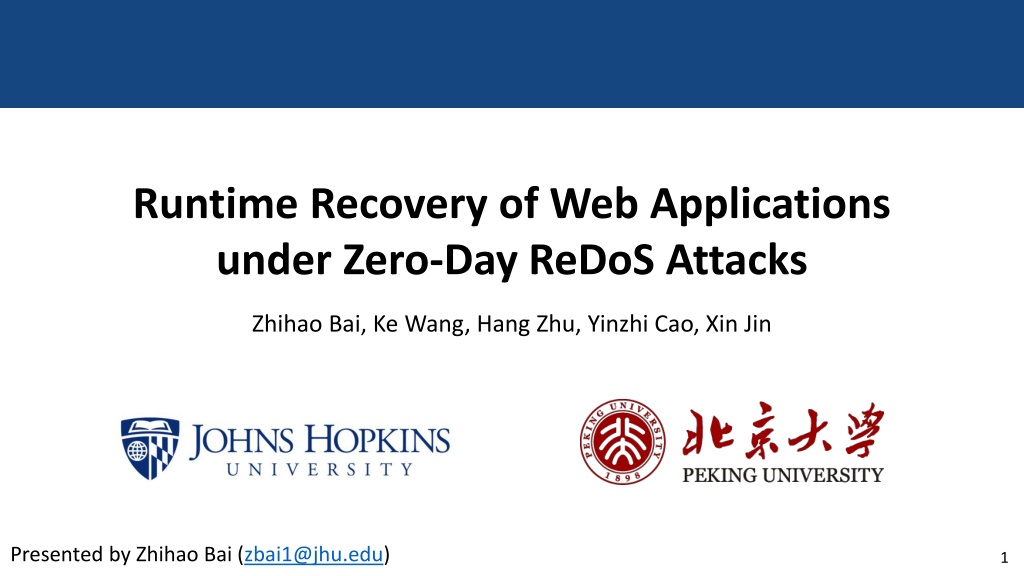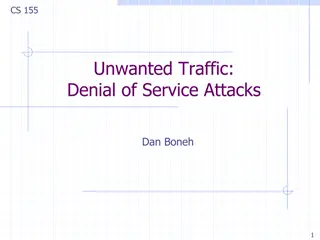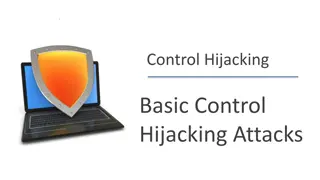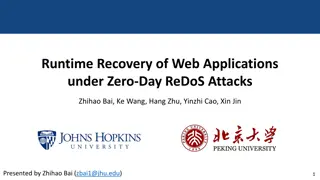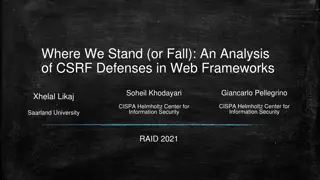Understanding ReDoS Attacks in Web Applications
The article discusses the vulnerability of web applications to Zero-Day ReDoS attacks and the impact of Regular Expression Denial of Service (ReDoS). It explores the use of regex in HTTP requests, the severity of ReDoS incidents, and practical examples of ReDoS vulnerabilities in popular websites and libraries. The study sheds light on the significance of runtime recovery and the serious implications of ReDoS in the cybersecurity landscape.
Download Presentation

Please find below an Image/Link to download the presentation.
The content on the website is provided AS IS for your information and personal use only. It may not be sold, licensed, or shared on other websites without obtaining consent from the author. Download presentation by click this link. If you encounter any issues during the download, it is possible that the publisher has removed the file from their server.
E N D
Presentation Transcript
Runtime Recovery of Web Applications under Zero-Day ReDoS Attacks Zhihao Bai, Ke Wang, Hang Zhu, Yinzhi Cao, Xin Jin Presented by Zhihao Bai (zbai1@jhu.edu) 1
Regular expression (regex) is widely used HTTP GET request Server Client 2
Regular expression (regex) is widely used GET / HTTP/1.1 Host: example.com Accept: application/xml Content-Type: text/html; charset=UTF-8 Server Client 3
Regular expression (regex) is widely used Linear time GET / HTTP/1.1 Host: example.com Accept: application/xml Content-Type: text/html; charset=UTF-8 Match regex: charset=([\w\-]+) Result: UTF-8 Client Server 4
Regular expression Denial of Service (ReDoS) Super-linear time GET / HTTP/1.1 Host: example.com Accept: application/xml Content-Type: text/html; charset=UTF-8 (?: charset|encoding)\s*=\s*[ ]? *([\w\-]+) Match regex: charset=([\w\-]+) Result: UTF-8 Client Server 5
ReDoS is a serious problem 34-minute outage of StackOverflow[1] Caused by an unknown ReDoS vulnerability 13,723 vulnerable libraries[2] 2% of all libraries in npm and PyPI 339 popular websites[3] Most of them have more than 100,000 popularity [1] https://stackstatus.net/post/147710624694/outage-postmortem-july-20-2016 [2] Davis, James C., et al. "The impact of regular expression denial of service (ReDoS) in practice: an empirical study at the ecosystem scale." Proceedings of the 2018 26th ACM joint meeting on European software engineering conference and symposium on the foundations of software engineering. 2018. [3] Staicu, Cristian-Alexandru, and Michael Pradel. "Freezing the web: A study of ReDoS vulnerabilities in JavaScript-based web servers." 27th USENIX Security Symposium (USENIX Security 18). 2018. 6
-NFA is used to match regex a*a*b a a ? ? b ?1 ?2 Start Accept 7
String a is not accepted by (a*a*b) a*a*b a a ? ? b ?1 ?2 Start Accept a 8
Regular expression Denial of Service (ReDoS) a*a*b a a ? ? b ?1 ?2 Start Accept aaaaaaaaa 9
Regular expression Denial of Service (ReDoS) a*a*b a a Malicious payload obeys certain underlying pattern! ? ? b ?1 Deep learning ?2 Start Accept aaaaaaaaa [4] W stholz, Valentin, et al. "Static detection of DoS vulnerabilities in programs that use regular expressions." International Conference on Tools and Algorithms for the Construction and Analysis of Systems. Springer, Berlin, Heidelberg, 2017. 10
11 Threat model Malicious request Adversary Server Vulnerable regex 11
12 Threat model: reflected ReDoS Malicious request Adversary Server Vulnerable regex 12
13 Threat model: stored ReDoS Malicious Request Server Database Adversary Client Vulnerable regex 13
RegexNet Overview Effective Responsive Resilient Low-overhead Scalable and fault-tolerant 14
DNN-based detection model Spatial Pyramid Pooling layer Fully Embedding layer Conv1d layer Connected layer 15
Detect malicious requests Client Server Load Balancer 16
Detect malicious requests Client Server Load Balancer Detector (An optional design with high overhead) 17
Detect malicious requests Client Server Load Balancer Copy Notify Detector 18
Request migration Migrate Sandbox Client Server Load Balancer Detector 19
Training the DNN model Sandbox Server Client Load Balancer Report Update Data Collector Detector 20
Implementation About 2,000 lines of code https://github.com/netx-repo/RegexNet Load balancer Customized HAProxy Server Node.js application with C++ shim layer Detector Python with PyTorch framework 21
Evaluation How resilient is RegexNet against various ReDoS attacks? How fast is RegexNet in recovering web service under ReDoS attacks? How does RegexNet compare with state-of-the-art reactive defense? How effective is RegexNet under different malicious loads and message sizes? What is the accuracy of RegexNet s DNN model especially with an imbalanced or polluted training set? 22
Evaluation How resilient is RegexNet against various ReDoS attacks? How fast is RegexNet in recovering web service under ReDoS attacks? How does RegexNet compare with state-of-the-art reactive defense? How effective is RegexNet under different malicious loads and message sizes? What is the accuracy of RegexNet s DNN model especially with an imbalanced or polluted training set? 23
Methodology Environment AWS Metrics Throughput Latency Recovery time Network Traffics Benign requests: Apache benchmark Malicious requests: Python program that sends crafted HTTP requests 24
26 Throughput under adaptive attacks 26
27 Throughput under adaptive attacks RegexNet is resilient against all kinds of ReDoS attacks. 27
Recovery time under unknown ReDoS attacks Baseline RegexNet 28
Recovery time under unknown ReDoS attacks Baseline RegexNet RegexNet can quickly recover web services. 29
Summary Propose RegexNet, a ReDoS recovery system for web services Leverage a learning model Design an online feedback loop Update model constantly Implement a system prototype Demonstrate its effectiveness 30
Thank you! Contact: zbai1@jhu.edu Open source: https://github.com/netx-repo/RegexNet 31
